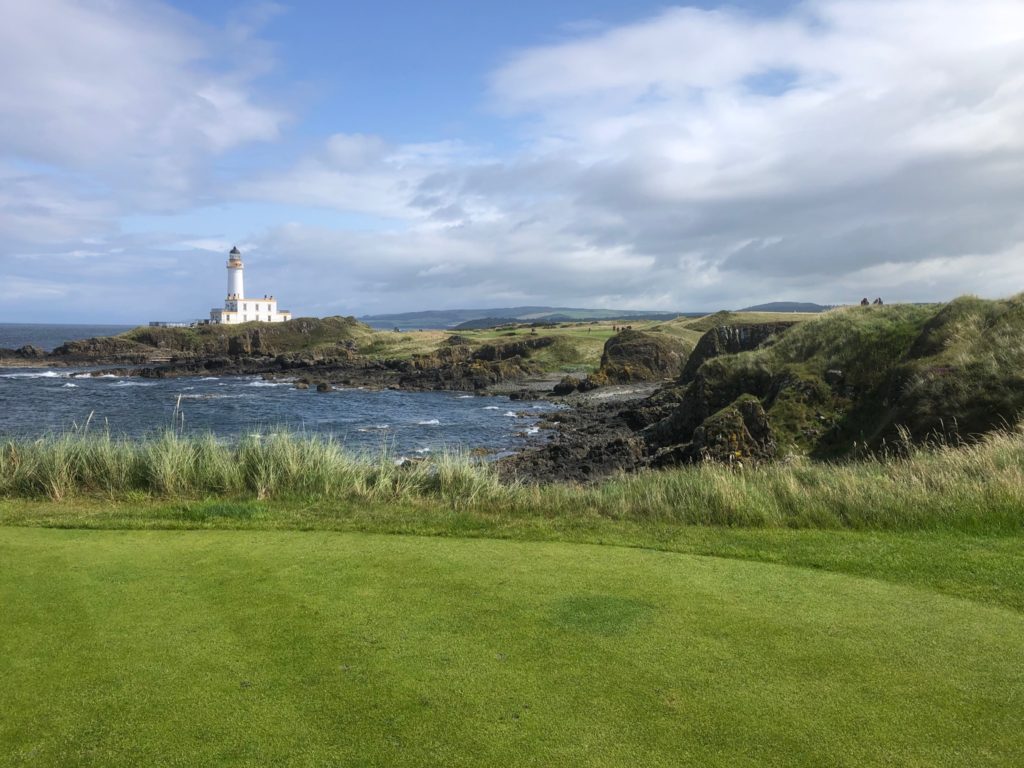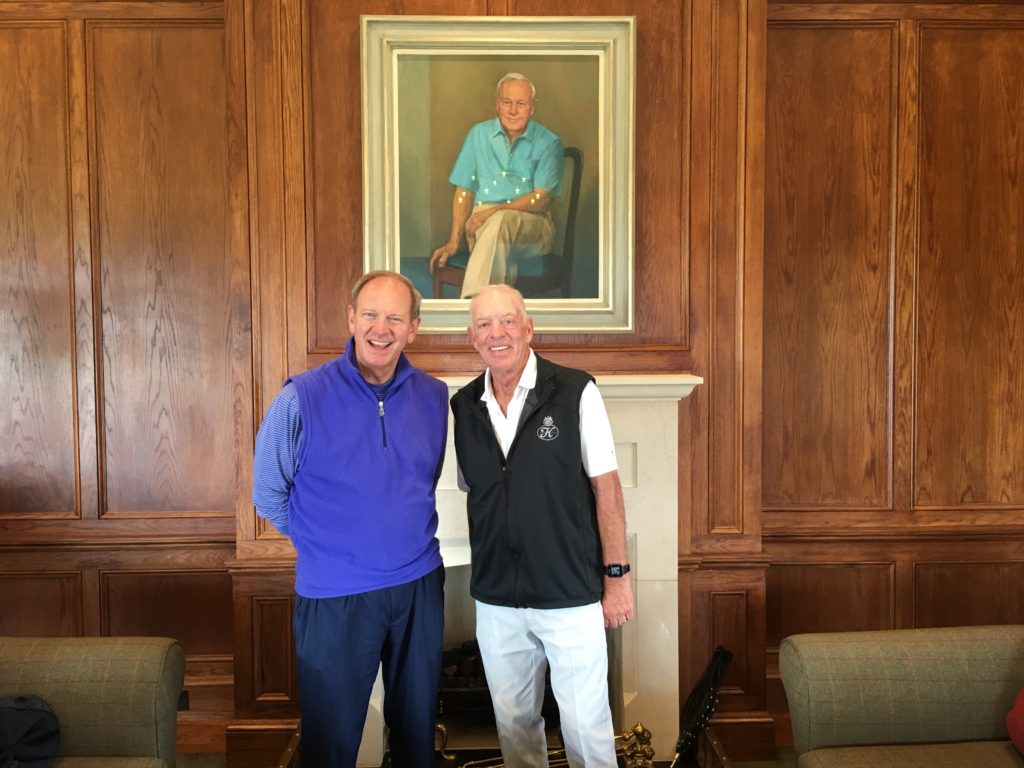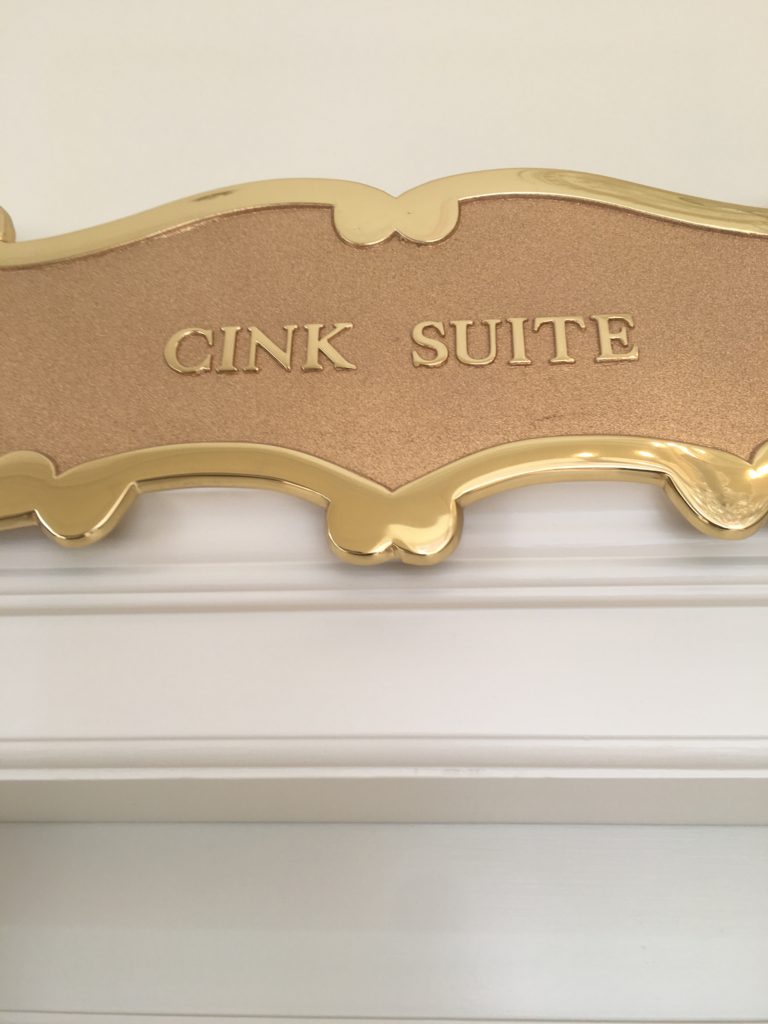The Open – Irish Eyes Were Smiling

Shane Lowry
The lighthouse at Turnberry
With Ret. Col. Bill Hudson and The King
Irish eyes were smiling!
Were they ever!
It was all about the Open.
The fourth and final grand slam in this year’s pro golf calendar.
So much anticipation before it all began at Royal Portrush in Northern Island.
And so much joy at the end.
Call it a storybook tale.
A tale that brought your faithful reporter to the cusp of the dramatic happenings.
You see, what is to follow is a postcard from Scotland, then Ireland.
To a front seat witnessing the resounding elation of the Irish folk when the champion’s name was etched on the Claret Jug.
Let’s start from the very beginning.
A planned week-long excursion was set up by our Florida golf club, arranged by Signature Golf, bringing together members from several clubs to play several courses and attend the third round of the Open.
So, Jamie and I found ourselves in the presence of members of the distinguished Army Navy Country Club in Arlington, Virginia, along with many from our club at Broken Sound in Boca Raton, Florida.
Leading the way were two of our outstanding professionals, Matt Newman, and Kent Graham.
Graham has an impressive sports lineage.
His grandfather was Otto Graham, the great quarterback of the Cleveland Browns who led his team to five consecutive world championships and seven in 10 years.
If you’re foggy on Otto, look him up.
You’ll say “wow”.
If you follow the sport, you’re aware how stunningly different golf is in Scotland, where it was invented, Ireland, and Great Britain.
The courses there are called links courses.
They are located at coastal areas. Seaside locations where wind and rain are the rule, not the exception.
They feature undulating surfaces, a firm turf where balls bounce far and roll far. That is, unless you hit into the “gorse”, the high grass where you are certain to lose your ball. That is why you hire a caddy. Usually, a crusty veteran of the area who not only will find your ball every time, but will tell you where to hit your shot and how far to hit it. It’s comical if you’re just an average player at best.
Did I mention the “pot bunkers”?
Oh, those are small sand bunkers which affect your every shot leading down the fairway, all the way to the green.
There are many and they’re easily found.
They are deep because a wall of several feet dares you to advance your ball. So if you are able to get the ball out you might have to hit it sideways, or even backwards, away from the green.
Then, there are the weather conditions.
You’ll probably experience sun, rain, sometimes heavy, and winds, also sometimes heavy.
These golf courses are a far, far, cry from what we’re used to in the good old USA.
But everyone on the journey had to experience what the pros experience when they play the Open.
In our country, we call it the British Open. We have our U.S. Open.
There, it’s simply, The Open.
Remember, they were there first.
This year’s Open was the 148th playing of the event.
But it was the first played in Ireland since 1951.
That’s an incredible 68 years The Open has been hosted by either Britain or Scotland before it returned to the Emerald Isle.
It was easy to pinpoint the favorite son going in.
It had to be Rory McIlroy, the popular Irish pro, and one of the big favorites on the Tour.
McIlroy has fallen short lately where so much is expected of him.
He had won four majors, but never The Open, and not one in the past five years.
So here he was, with a chance to make his fellow-countrymen incredibly proud, playing where the Open hadn’t been played in 68 years, and on the very course he set a new competitive course record.
Rory, as a 16-year old in 2005, shot a 61 on the Dunluce links at Royal Portrush.
What could be better for him? A chance to cash in with what would be one of legendary performances in golfing annals.
So it was collision course for our group, as we played some marvelous courses, beginning in Scotland.
First up, Royal Troon Golf Club southwest of Glasgow in a town called Ayrshire.
This is where Arnold Palmer captured his second consecutive Open in 1962.
It was the best weather we experienced. Yes, there was some rain and wind, but it was apparent we hadn’t gotten the taste of the “real” conditions.
When you play these courses, you walk with your caddy.
You walk on uneven terrain. You walk up hills and down hills. You walk in high grass, and you step into those pot bunkers. You also have to step out of them, which is a lot more difficult.
So imagine, walking 18 holes for four straight days, trying to hit shots that won’t put you in more trouble.
At the hotel in Turnberry, we stayed in a room next to the Cink Suite, honoring Stewart Cink who won the Open in 2009 on the course we would play on our particular tour.
I’ve gotten to know Cink, a true gentleman and a person of class. He’s a lot more.
Cink was a true warrior in his care for his wife Lisa, supporting her by taking a year off during her battle with breast cancer in 2016. Stewart found himself in a fight with skin cancer two years later.
But he was quick to relate how the two were incomparable. He has stated unequivocally that Lisa has been an inspiration to him.
He would be playing, of course, as a past champion at Royal Portrush, and we looked forward to seeing him in the third round, knowing he had to make the cut to get there.
Following our “fun” at Royal Troon, the next day at Prestwick saw the conditions change to heavy rains, for the most part, with winds 15-20 mph driving almost horizontally in our faces as we played into the squall.
Prestwick was the scene of the very first Open, held in 1860. They played there 24 times.
So there was history, no doubt.
On the last day in Scotland, we finally played the Turnberry course. A beauty. With the wonderful lighthouse as the landmark, the weather conditions were better than the day before.
But the rain was never for behind.
As we shifted to Belfast, getting closer to our moment at the major, the developments that were taking place at Royal Portrush we’re creating a buzz.
Rory McIlroy was not to be the Irish hero as people had hoped.
In fact, McIlroy crashed and burned, not making the cut and scoring an unbelievable 8 on the very first hole of the tournament.
He missed the cut by only one stroke after a brilliant second round. Too little, too late.
But it wasn’t all doom and gloom for the Irish.
A 32-year old who was born and grew up a mere four miles from Royal Portrush was burning up the course on the day we witnessed the action in person.
It was Shane Lowry, who had never won a major championship.
Grabbing the baton from the fallen McIlroy, this bearded, beer-drinking (Guinness, I presume), joyful fellow with a constant wide smile on his face, opened up a five shot lead. The crowd sang the chants of “Shane-o, Shane-o”, in what resembled more of a crowd at a soccer match than at a golf tournament. But well behaved, the throng was. They knew their golf.
Our personal mission to see Stewart Cink was also a success. Walking all the way to the 8th green and back was like marching the 18 we were now accustomed to.
Finally, after Cink, who obviously made the cut, sank his putt for par at 8, he waited before moving on to the 9th tee. During that lull, I was able to greet my friend, shake his hand, and wish him luck. I told him we just missed staying at the Cink Suite at Turnberry by one room.
Cink finished -1 tied for 20th. Not too shabby.
On the final day of the Open, our group journeyed to Portmarnock for our final round of golf.
It was situated by the sea like they all were, and we experienced our last day of links golf in the British Isles.
But the crowning moment was not on the course playing golf, but viewing the final holes of the Open in the tap room where members of the club gathered in an anticipation that was hardly expected a week before.
Here were the members, dressed in suits and ties, watching in a low key manner, but deeply hoping Shane Lowry would finish the job.
The weather deteriorated on that Sunday, and Lowry and the other top 23 golfers failed to shoot par.
It didn’t matter.
It turned out to be a coronation for the Lowry as he held off his challengers with ease, and gave the Irish people what they wanted. A championship won by one of their own in their country, hosting the Open for the first time in 68 years.
Then, a somewhat shocking development.
One of the members informed me that Rory McIlroy was not looked upon as fondly as everyone thought.
It seems when Rory decided to skip the Irish Open, many looked upon his decision with disdain.
It seems the Irish Open has as much significance, if not more, than The Open itself, the last major of the golf season Open itself, the last major of the golf season.
Is anyone really surprised, now when you think about it.
As for our group, it was a smashing success.
Having the experience of witnessing a round of the Open, playing links golf and all that entails, with the climate changing at every turn, reuniting with our friends from Broken Sound, and meeting new friends like Bill Hudson, and Mike Delaney from the Army Navy Country Club was priceless.



